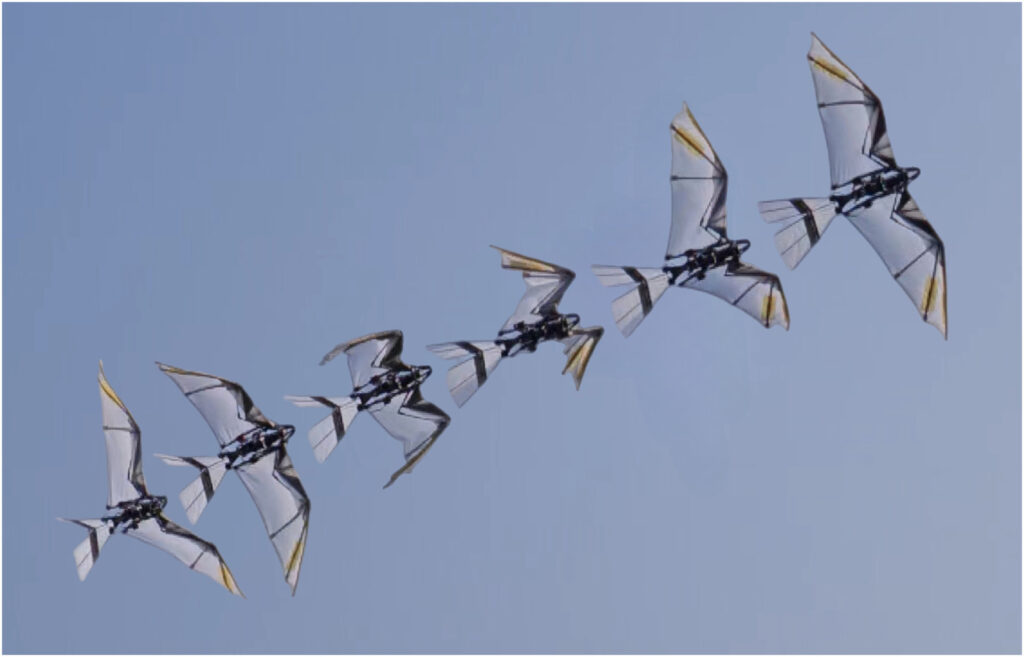In 2021, a group of scientists from China engineered the RoboFalcon—a bird-inspired flapping-wing robot with a newly engineered mechanism made to drive bat-style morphing wings capable of flight. While this bio-inspired robot performed well at a cruising speed, it was not capable of flying at lower speeds or achieving takeoff without assistance.
Now, the same group of researchers has upgraded their design. Their work, published in Science Advances, describes the RoboFalcon 2.0, which incorporates an 800 g body and reconfigurable mechanisms in the wings to couple flapping, sweeping, and folding in one wingbeat. This more sophisticated wing system allows the RoboFalcon 2.0 to achieve takeoff without assistance and to stay in flight at lower speeds.
Most prior bio-inspired flying robotics have relied on single degree-of-freedom (DOF) wing kinematics that mimic insect- or hummingbird-style symmetrical hovering, instead of the three DOF kinematics used by larger birds and bats—simplistically described as wing flapping, sweeping, and folding. To recreate these more complicated wing motions, the team developed reconfigurable mechanisms using a combination of decouplers that enable flapping, sweeping, and folding (FSF) to occur in one wingbeat.
“These mechanisms ensure that the RoboFalcon2.0 can take off and fly forward using the ventral anterior flapping downstrokes with the tucked upstrokes to generate lift and thrust, namely, the bird-style takeoff. The wing sweeping and folding amplitude can also be tuned for pitch and roll control during flapping,” the study authors explain.
The team used wind tunnel experiments, simulations, and real-world flight tests to analyze the performance of the design. The wind tunnel tests and simulations showed that increasing wing sweep enhances lift and pitching momentum, aiding takeoff and pitch control. The authors also say that the takeoff and pitch control capabilities of FSF wing motion were verified by their real-world flight demonstration.
While the new design has taken several steps forward in the engineering of life-like flying robots and has overcome the hurdle of self-takeoff, the team believes that it can be further improved in the future. They say a tail elevator is needed for stability during higher speeds and that energy efficiency during takeoff is lower than in insect-scale robots or real birds. They also found that RoboFalcon 2.0’s real-world hovering ability is limited by a lack of yaw control.
The study authors write, “The actuation mechanisms proposed here emulate the kinematics of flying vertebrates’ low-speed flight to a greater extent within the scope of mechanical technology and reduce the attitude control complexity by deploying a proper underactuation strategy. This enables a previously unexplored robotic flapping takeoff using ventral-anterior downstroke and tucked upstroke, providing alternative perspectives and methodologies for avian-inspired robotics and avian locomotion research.”
Written for you by our author Krystal Kasal, edited by Gaby Clark, and fact-checked and reviewed by Robert Egan—this article is the result of careful human work. We rely on readers like you to keep independent science journalism alive.
If this reporting matters to you,
please consider a donation (especially monthly).
You’ll get an ad-free account as a thank-you.
More information:
Ang Chen et al, Flapping-wing robot achieves bird-style self-takeoff by adopting reconfigurable mechanisms, Science Advances (2025). DOI: 10.1126/sciadv.adx0465
© 2025 Science X Network
Citation:
Bird-like robot with novel wing system achieves self-takeoff and low-speed flight (2025, September 19)
retrieved 21 September 2025
from https://techxplore.com/news/2025-09-bird-robot-wing-takeoff-flight.html
This document is subject to copyright. Apart from any fair dealing for the purpose of private study or research, no
part may be reproduced without the written permission. The content is provided for information purposes only.

